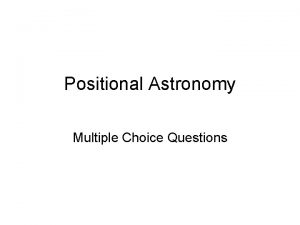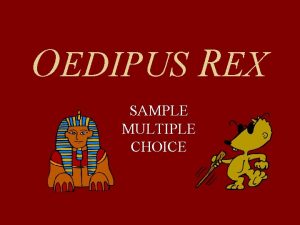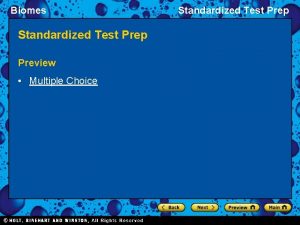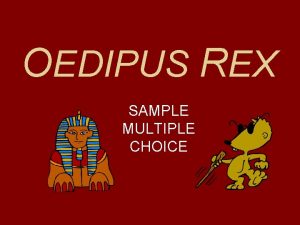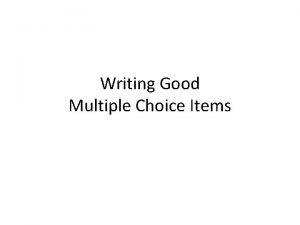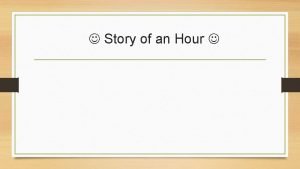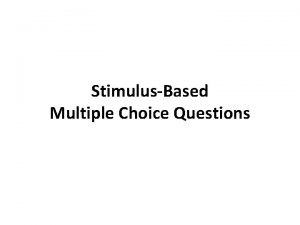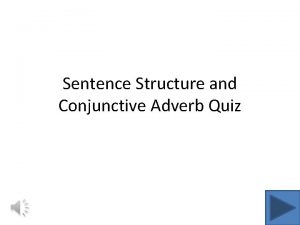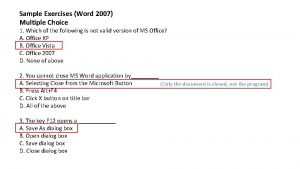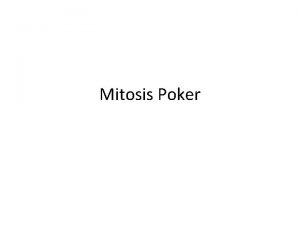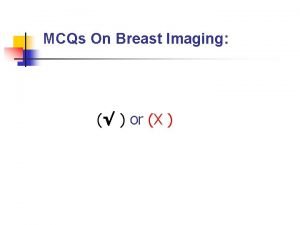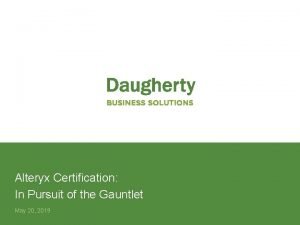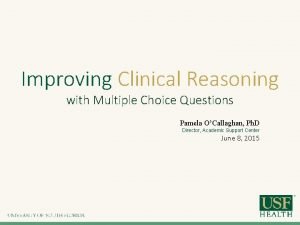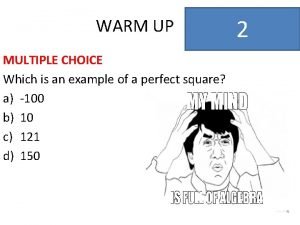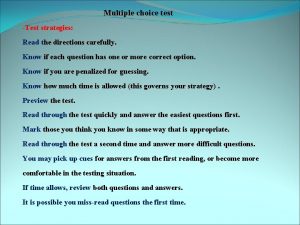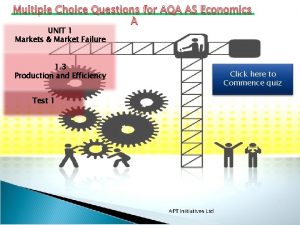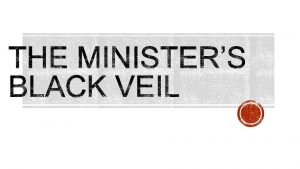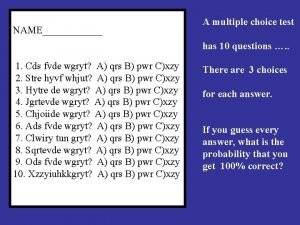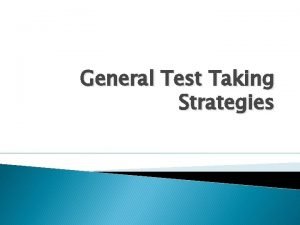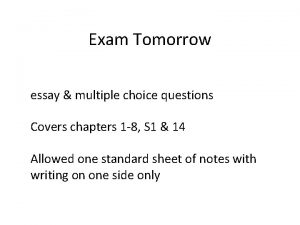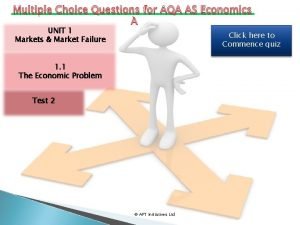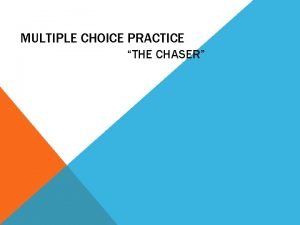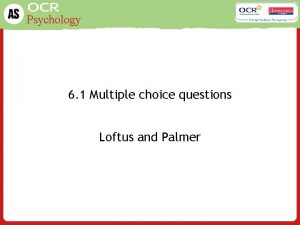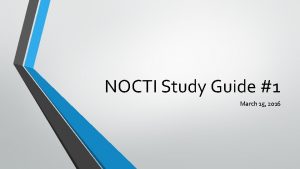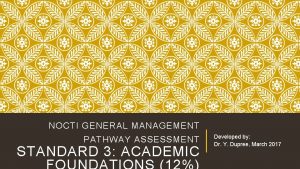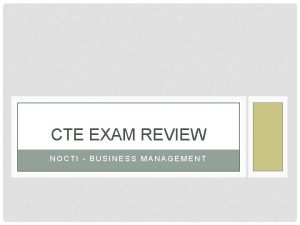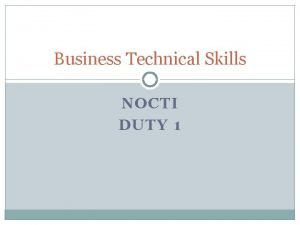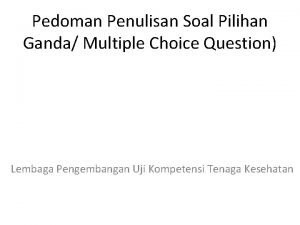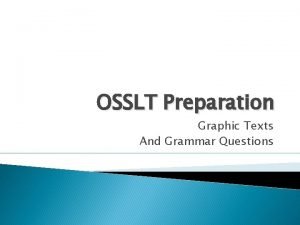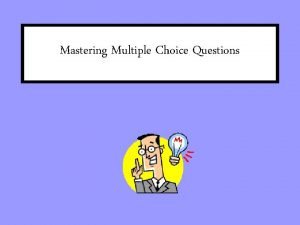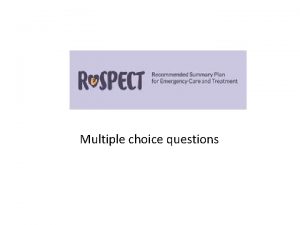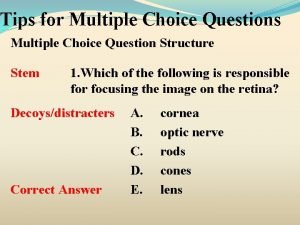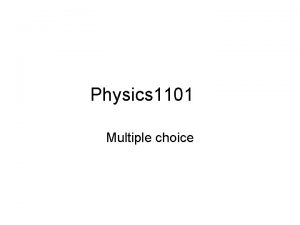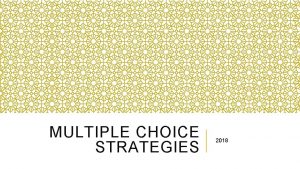NOCTI Prep Questions multiple choice answers are at



























































- Slides: 59

NOCTI Prep Questions (multiple choice answers are at the end of this presentation, so you can check yourself)

1. Susan opened a business and invested $5000 in cash and a computer worth $2500. These investments will increase A. Assets by $5000 B. Assets by $7500 C. Liabilities by $5000 D. Liabilities by $7500

2. The journal entry to record cash investment by the owner would by to debit Cash and credit A. Accounts Receivable B. Drawing C. Capital D. Expense

3. Jason invested $15000 cash to start his business. How would this transaction impact the basic accounting equation? A. There is no impact to the accounting equation B. Increase owner’s equity by $15000 C. Increase liabilities by 15000 D. Increase accounts payable by $15000

4. Debbie has a balance of $8600 in Accounts Receivable before receiving a check for $3455 from a customer she had worked for last month. What will be the balance in Accounts Receivable after she records the receipt of this check? A. 3455 B. 5145 C. 8600 D. 12055

5. Copying debits and credits from a journal to a ledger is a process known as A. Journalizing B. Posting C. Factoring D. Accruing

6. When posting the adjusting entries from page 8 of a general journal, the correct posting reference in the ledger accounts would be A. Page 8 B. GJ 8 C. PR-8 D. J-8

7. To prove the accuracy of posting, an accountant uses the A. Trial balance B. Closing entries C. Final balance D. Confirmed entries

8. A controlling account is a/an A. Account that records the amount owed from various companies in exchange for goods and/or services B. Account that records transactions which are settled on a cash basis C. Subsidiary ledger containing only charge customers D. Account in a general ledger that summarizes all of the individual accounts from a subsidiary ledger

9. An employee works 38 hours per week, is paid $8. 50 per hour, and is paid biweekly. What is the gross pay the employee will receive each pay period? A. $323. 000 B. $482. 00 C. $646. 00 D. $725. 00

10. A W-2 form is a/an A. Annual statement of earnings and tax deductions A. B. Withholding certificate for tax purposes A. C. W-4 Transmittal of wage and tax statements A. D. W-2 W-3 Employment eligibility verification A. I-9

11. An employee earns a commission of 7 percent of total sales. This week the employee’s total sales were $2345. What was the commission earned for the week? A. $164. 15 B. $1641. 50 C. $2180. 85 D. $2509. 15

12. The tax that is paid by employers to provide temporary relief for individuals who are out of work is called ____ tax. A. Income B. Unemployment C. Sales D. FICA

13. A direct deposit made to an employee’s checking or savings account is also known as a/an a. ATM- automated teller machine b. FICA-Federal Insurance Contribution Act c. EIN – Employee Identification Number d. EFT- Electronic Funds Transfer

14. Checks that are paid by the bank and then removed from the depositor’s account are called _____ checks. A. Cashiers B. Cancelled C. Refund D. Outstanding

15. A company had $3000 in credit card sales during the day. The company is charged a 3 percent discount rate on credit card deposits. The entry to record the credit card sales is A. Debit Cash 2910; debit Credit Card Expense 90; credit Sales 3000 B. Debit Cash 2910; credit Sales 3000 C. Debit Cash 3000; credit Sales 2910; credit Card Expense 90 D. Debit Cash 3000; credit Sales 3000

16. A check is a/an A. Certificate documenting the shareholder’s ownership in the corporation B. Document signed by a borrower promising to repay a loan under agreed-upon terms C. Official document prepared by the carrier duly accepting the goods for shipment D. Signed statement ordering a bank to pay cash from funds deposited in that bank

17. An endorsed check must have an authorized _______ on the back of the check. A. Embossment B. Thumb print C. Signature D. Bank stamp

18. A bank statement reconciliation is A. A statement that specifies the amount and account the funds are being deposited into B. A summary of all financial transactions occurring over a period of time on an account C. A summary of the financial balances of a company D. An account audit used to bring information on a bank statement and a checkbook into agreement

19. A purchase of a computer with cash A. Is a shift in assets B. Increases a liability C. Decreases an asset D. Increases an asset

20. During one accounting period, a corporation’s beginning inventory was $17, 000 and they purchased $85, 000 of merchandise. The cost of the goods sold for that period was $94, 000 and sales were $110, 000. What is the merchandise inventory amount on the financial statement? A. $8000 C. $86000 B. $16000 D. $110000

21. The two accounts used to adjust the merchandise inventory are Income Summary and A. Merchandise Inventory B. Beginning Merchandise Inventory C. Ending Merchandise Inventory D. Total Merchandise Inventory

22. Sales tax is applied at the rate of 6. 5 percent. The entry record, cash sales of merchandise for $100, requires a credit to the Sales Tax Payable account for A. $0. 65 B. $6. 50 C. $35. 00 D. $650. 00

23. Adjusting entries are recorded in the general ledger A. At the beginning of the fiscal period B. At the end of the fiscal period C. At the midpoint of the fiscal period D. Continuously throughout the fiscal period

24. If a journal debit entry of $150 is incorrectly posted as a credit the trial balance will be out of balance by A. $50 B. $75 C. $150 D. $300

25. The term for changing the arrangement of a number is called A. Subtraction B. Transposition C. Mistake D. Addition

26. The business form sent monthly to each charge customer is known as a A. Statement of account B. Sales invoice C. Purchase order D. Cycle bill

27. A promissory note is the source document for issuing a A. Sales invoice B. Note payable C. Note receivable D. Purchase order

28. A business form that is prepared after merchandise is sold to a customer is called A. Purchase order B. Shipping order C. Sales invoice D. Statement of account

29. Which would be used to demonstrate employee commissions over a three-year span? A. An area graph, which displays graphically quantitative data B. A line chart, which displays information in a series of data points connected by a straight line. C. A stock chart, which displays the fluctuations of stock prices or scientific data. D. A scatter plot, which displays values for two variables for a set of data using Cartesian coordinates.

30. In an electronic spreadsheet, the intersection of a row and a column is called a A. Pigeon hole B. Cell C. Coordinate D. Slot

31. On a discounted 6 percent, 6 month, non-interest bearing note for $5000, the bank would credit the associated checking account for the proceeds of A. $150 B. $300 C. $4, 700 D. $4, 850

32. An invoice dated on March 10 with the terms 3/60, n/90 means that a 3 percent discount will be given if the invoice is paid on or before A. May 7 C. May 9 B. May 8 D. May 10

33. To prevent identity theft, A. Remove Social Security number from personal checks B. Ensure the Social Security number is located on personal checks C. Scramble Social Security number on personal checks D. Highlight Social Security number on personal checks

34. An audit trail is the transaction flow from the point of origination to the A. Bank B. Business C. Accountant D. Final document

35. Which of the following organizations establishes standards for financial accounting and reporting in the public sector? A. Financial Accounting Standards Board B. International Accounting Standards Board C. Governmental Accounting Standards Board D. General Accounting Standards Board

Multiple Choice Answers 1 -35

1. B 2. C 3. B 4. B 5. B 6. B 7. A 8. D 9. C 10. A 11. A 12. B 13. D 14. B 15. A 16. D 17. C 18. D 19. A 20. A 21. A 22. B 23. B 24. D 25. B 26. A 27. B 28. C 29. B 30. B 31. D 32. C 33. A 34. D 35. A

Additional Study Information/Links and Questions

What do these acronyms represent? A. FASB B. GAAP C. CPA D. CFO

What are common bank accounts for a business to have? A. General Checking Account B. Payroll Account C. Dividends Account D. All of the above

Promissory Note – pg. 589 A written and signed promise to pay a sum of money at a specified time that provides evidence of the transaction. The value at maturity is the principal plus the interest. The date on which the note is written is not counted, but the maturity date is counted. Determine the fraction of the year by putting the number of days over 360, so 90/360=. 25=time P=principal R=rate T=time P*R*T=interest due $3000*. 06*. 25= $45 for 90 days $3000*. 06*1= $180 for 360 days

Name two supporting schedules, also know as supplementary reports or exhibits. Where do you get the information to make them? (from the A. R. Ledger and A. P. Ledger) A. Schedule of Accounts Receivable B. Schedule of Accounts Payable

How would a business follow up on outstanding checks? A. Void the check or Reissue a new check

Determining the Quantity of Merchandise Inventory Too much or too little inventory can cause a business to fail. Periodic or Perpetual (UPC=Universal Product Code, helps keep perpetual inventory records) Just in Time Inventory Management Three inventory costing methods: LIFO (Hardware Store), FIFO (Grocery Store), & Weighted Average. p. 572 Comparison – how to choose

Compare batch processing to real time processing.

Biometrics: an automated method of recognizing a person based on a physical characteristic (fingerprint, retina, & facial recognition)

Concept of Materiality is applied when the amount of an error or omission in the accounting records is not large enough to affect business decisions. $2, 000 would be material to many businesses, but immaterial to a large corporation.

Reporting income when it is earned and expenses when they are incurred is called the accrual basis of accounting. True or False

Reporting income when cash is received and expenses when cash is paid is called the cash basis of accounting. True or False

Sarbanes-Oxley Act of 2002 (SOX) was designed to protect investors by improving the accuracy and reliability of financial reporting.

Segregation of Duties helps avoid fraud. (SOD) is a part of risk management and internal controls for a business. The principle of SOD is based on shared responsibilities of a key process that disperses the critical functions of that process to more than one person or department. Without this separation in key processes, fraud and error risks are far less manageable.

What is a Lookback Period? The timeframe used to determine whether a company is paying employment taxes on the correct depositing schedule. The lookback period begins on July 1 and ends on June 30 of the following year. Based on the total amount of taxes paid during this time period, a company is to determine whether it should pay taxes on a semiweekly or monthly basis.

Crediting the estimated value of uncollectible accounts to a contra account is called the allowance method of recording losses from uncollectible accounts.

Once an account is determined to be uncollectible, a journal entry is made to cancel the uncollectible account. This entry cancels the uncollectible amount from the general ledger account Accounts Receivable as well as the customer account in the A. R. Subsidiary ledger. Canceling the balance of a customer account because the customer does not pay is called writing off an account.

When a business extends credit to customers, some customers might be unable to pay on the spot. The direct write-off method is one way to account for these uncollectible receivables. With this method, a business writes off an account only when it determines that a customer cannot pay. This differs from the allowance method, which requires a business to estimate its uncollectible accounts each period. The direct write-off method is simpler to use, but its drawbacks might make it inappropriate for some small businesses. Sponsored Link #1 Local Factoring Co. www. businessfactors. com 24 Hr Local Receivables Funding. Simple & Fast Approval. Call 24/7! Violates Matching Principle When a business writes off an uncollectible account, it charges the amount as a bad debt expense on the income statement. With the direct write -off method, this expense might occur in a period after the initial sale was recorded, which violates the matching principle of generally accepted accounting principles, or GAAP. The matching principle requires a business to record revenues and their related expenses in the same accounting period. Because of this violation, GAAP allows a business to use the direct write-off method only for insignificant amounts. Overstates Accounts Receivable Accounts receivable is an asset on the balance sheet that represents the money customers owe. A business that uses the direct write-off method records the full amount of an account receivable at the time of a sale. But if some of these accounts become uncollectible, the reported accounts receivable balance would be too high. For example, if your small business uses the direct write-off method and reports $100, 000 in accounts receivable, the balance can be misleading because you might collect less than the full $100, 000. Inaccurate Profits Profit equals revenue minus expenses. Because a bad debt expense sometimes occurs in a later period than its related revenue, a company’s profits on its income statement might be inaccurate. Its profit would be too high when it records the revenue and too low when it records the related bad debt expense. For example, assume your small business records a $5, 000 sale in the first quarter and writes that $5, 000 off in the second quarter. Your first-quarter profit would be $5, 000 too high and your second-quarter profit would be $5, 000 too low. Potential for Abuse The direct write-off method allows more room for manipulation than other methods. Although a company is supposed to write off an account as soon as it determines the account to be uncollectible, it uses its judgment to decide when that moment arrives. This leeway allows an unethical company to inappropriately manage its profits. For instance, if a business wants to artificially raise its profits, it might overlook some past-due accounts until a later period so it can delay reporting the bad debt expense

Uncollectible Accounts & Bad Debt Discussion

Look at chart of accounts and put -an A by asset accounts -a L by liability accounts -a S by Stockholders’ Equity Accounts -a P by permanent accounts (Real) -a T by temporary accounts (Nominal) -a C by contra accounts -an E by expense accounts -an R by revenue accounts -an M by Cost of Merchandise Accounts

 Nocti test prep
Nocti test prep Insidan region jh
Insidan region jh Astronomy questions and answers multiple choice
Astronomy questions and answers multiple choice Oedipus multiple choice questions
Oedipus multiple choice questions Biomes multiple choice questions with answers
Biomes multiple choice questions with answers Oedipus rex ap multiple choice questions
Oedipus rex ap multiple choice questions Ap lang test structure
Ap lang test structure Ap statistics chapter 7 test
Ap statistics chapter 7 test How to write multiple choice questions
How to write multiple choice questions Of a strange nature is the suit you follow
Of a strange nature is the suit you follow She carried herself unwittingly like a goddess of victory
She carried herself unwittingly like a goddess of victory What is stimulus in mcq
What is stimulus in mcq Multiple choice questions on sentence structure
Multiple choice questions on sentence structure Exercises for microsoft word
Exercises for microsoft word Multiple choice questions for primary students
Multiple choice questions for primary students Multiple choice questions on persuasion
Multiple choice questions on persuasion Poetry multiple choice sonnet
Poetry multiple choice sonnet Stem cell multiple choice questions
Stem cell multiple choice questions Mammography mcqs
Mammography mcqs Growth mindset multiple choice questions
Growth mindset multiple choice questions Alteryx certification
Alteryx certification Multiple choice questions on sustainable tourism
Multiple choice questions on sustainable tourism The command cal j 1997 would give the output as
The command cal j 1997 would give the output as Tone multiple choice questions
Tone multiple choice questions Multiple choice questions on photoelectric effect
Multiple choice questions on photoelectric effect Multiple choice questions on flowering plants
Multiple choice questions on flowering plants Vignette-style mcqs
Vignette-style mcqs Abolitionist movement ap world history
Abolitionist movement ap world history Quiz of conjunction
Quiz of conjunction Measles mcq
Measles mcq Solving quadratic equations multiple choice questions doc
Solving quadratic equations multiple choice questions doc Poetry analysis multiple choice questions
Poetry analysis multiple choice questions Test directions for multiple choice
Test directions for multiple choice Aqa economics multiple choice questions
Aqa economics multiple choice questions Multi choice
Multi choice How is kinetic energy used in rescue team missions
How is kinetic energy used in rescue team missions Multiple choice questions on dna structure and replication
Multiple choice questions on dna structure and replication A multiple choice test has 10 questions
A multiple choice test has 10 questions The scientist who discovered m. tuberculosis was: *
The scientist who discovered m. tuberculosis was: * Multiple choice questions on prokaryotes and eukaryotes
Multiple choice questions on prokaryotes and eukaryotes Multiple choice questions
Multiple choice questions Confirmation review questions
Confirmation review questions Multiple choice questions
Multiple choice questions Economics multiple choice questions aqa
Economics multiple choice questions aqa Examples of distractors in multiple-choice questions
Examples of distractors in multiple-choice questions Irony in the chaser
Irony in the chaser Silk road multiple choice questions
Silk road multiple choice questions Positive psychology multiple choice questions
Positive psychology multiple choice questions Pacemaker multiple choice questions
Pacemaker multiple choice questions Nocti study guide
Nocti study guide What was nocti original product line
What was nocti original product line Nocti general management study guide
Nocti general management study guide Nys kontör
Nys kontör Technical skills definition
Technical skills definition Good choice or bad choice
Good choice or bad choice Multiple binary choice items
Multiple binary choice items Apcs recursion
Apcs recursion Ap lit multiple choice tips
Ap lit multiple choice tips Vignette multiple choice
Vignette multiple choice Osslt grammar practice with answers
Osslt grammar practice with answers


